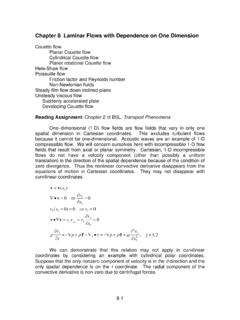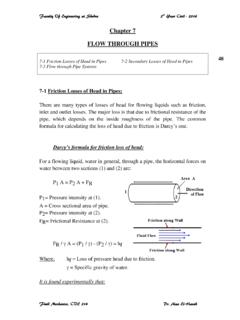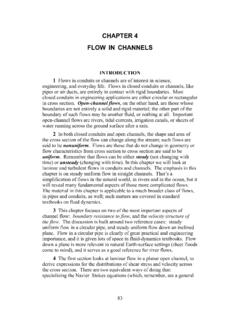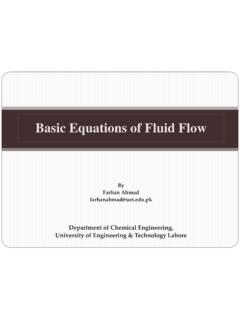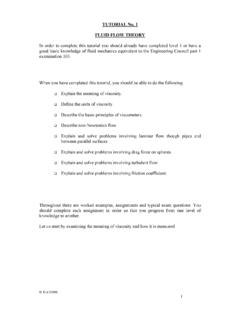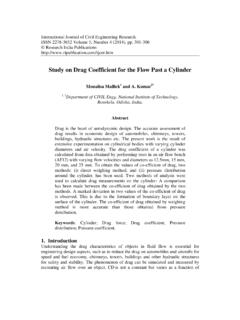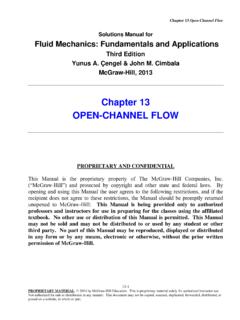Transcription of Open Channel Flow I - The Manning Equation and Uniform …
1 1 Open Channel Flow I - The Manning Equation and Uniform Flow Harlan H. Bengtson, PhD, COURSE CONTENT 1. Introduction Flow of a liquid may take place either as open Channel flow or pressure flow. Pressure flow takes place in a closed conduit such as a pipe, and pressure is the primary driving force for the flow. For open Channel flow, on the other hand the flowing liquid has a free surface at atmospheric pressure and the driving force is gravity. Open Channel flow takes place in natural channels like rivers and streams. It also occurs in manmade channels such as those used to transport wastewater and in circular sewers flowing partially full.
2 In this course several aspects of open Channel flow will be presented, discussed and illustrated with examples. The main topic of this course is Uniform open Channel flow, in which the Channel slope, liquid velocity and liquid depth remain constant. First, however, several ways of classifying open Channel flow will be presented and discussed briefly. Open Channel Flow Examples: A River and an Irrigation Canal 2 2. Topics Covered in this Course I. Methods of Classifying Open Channel Flow A. Steady State of Unsteady State Flow B. Laminar or turbulent Flow C. Uniform or Non- Uniform Flow D.
3 Supercritical, Subcritical or Critical Flow II. Calculations for Uniform Open Channel Flow A. The Manning Equation B. The Manning Roughness Coefficient C. The Reynold's Number D. The Hydraulic Radius E. The Manning Equation in Units F. The Manning Equation in Terms of V Instead of Q G. The Easy Parameters to Calculate with the Manning Equation H. The Hard Parameter to Calculate - Determination of Normal Depth I. Circular Pipes Flowing Full or Partially Full J. Uniform Flow in Natural Channels III. Summary IV. References and Websites 3. Methods of Classifying Open Channel Flow Open Channel flow may be classified is several ways, including i) steady state or unsteady state, ii) laminar or turbulent , iii) Uniform or nonuniform, and iv) subcritical, critical or supercritical flow.
4 Each of these will be discussed briefly in the rest of this section, and then Uniform open Channel flow will be covered in depth in the rest of the course. Steady State or Unsteady State Flow: The meanings of the terms steady state and unsteady state are the same for open Channel flow as for a variety of other flowing fluid applications. For steady state flow, there are no changes in velocity 3 patterns and magnitude with time at a given Channel cross section. Unsteady state flow, on the other hand, does have changing velocity with time at a given cross section. Unsteady state open Channel flow takes place when there is a changing flow rate, as for example in a river after a rain storm.
5 Steady state open Channel flow takes place when there is a constant flow rate of liquid is passing through the Channel . Steady state or nearly steady state conditions are present for many practical open Channel flow situations. The equations and calculations in this course will be for steady state flow. Laminar or turbulent Flow: Classification of a given flow as either laminar or turbulent is important in several fluid flow applications, such as pipe flow and flow past a flat plate, as well as in open Channel flow. In each case a Reynold s number is the criterion used to predict whether a given flow will be laminar or turbulent .
6 Open Channel flow is typically laminar for a Reynold s number below 500 and turbulent for a Reynold s number greater than 12,500. A flow with Reynold s number between 500 and 12,500 may be either laminar or turbulent , depending on other conditions, such as the upstream Channel conditions and the roughness of the Channel walls. More details on the Reynold s number for open Channel flow and its calculation will be given in Section 3, Calculations for Uniform Open Channel Flow. The Reynolds number is greater than 12,500, and thus the flow is turbulent for most practical cases of water transportation in natural or manmade open channels.
7 A notable example of laminar open Channel flow is flow of a thin liquid layer on a large flat surface, such as rainfall runoff from a parking lot, highway, or airport runway. This type of flow is often called sheet flow. Laminar and turbulent Flow Background: The difference between laminar and turbulent flow in pipes and the quantification of the conditions for each of them, was first observed and reported on by Osborne Reynolds in . His classic experiments utilized injection of dye into a transparent pipe containing a flowing fluid. When the flow was laminar he observed that they dye flowed in a streamline and didn t mix with the rest of the fluid.
8 Under turbulent flow conditions, however, the net velocity of the fluid is in the direction of flow, but there are eddy currents in all directions that cause mixing of the fluid, so that the entire fluid became colored in Reynold s experiments. Laminar and turbulent flow are illustrated for open Channel flow in figure 1. 4 Figure 1. Dye injection into laminar & turbulent open Channel flow Laminar flow is also sometimes called streamline flow. It occurs for flows with high viscosity fluids and/or low velocity and/or high viscosity. turbulent flow, on the other hand, occurs for fluid flows with low viscosity and/or high velocity.
9 Uniform or Non- Uniform Flow: Uniform flow will be present in a portion of open Channel (called a reach of Channel ) with a constant flow rate of liquid passing through it, constant bottom slope, and constant cross-section shape & size. With these conditions present, the average velocity of the flowing liquid and the depth of flow will remain constant in that reach of Channel . For reaches of Channel where the bottom slope, cross-section shape, and/or cross-section size change, non- Uniform flow will occur. Whenever the bottom slope and Channel cross-section shape and size become constant in a downstream reach of Channel , another set of Uniform flow conditions will occur there.
10 This is illustrated in Figure 2. Figure 2. Uniform and Non- Uniform Open Channel Flow 5 Supercritical, Subcitical, or Critical Flow: Any open Channel flow will be supercritical, subcritical or critical flow. The differences among these three classifications of open Channel flow, however, are not as obvious or intuitive as with the other classifications (steady or unsteady state, laminar or turbulent , and Uniform or non- Uniform ). Your intuition will probably not lead you to expect some of the behaviors for subcritical and supercritical flow and the transitions between them.

